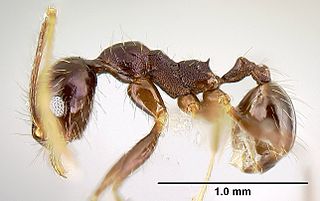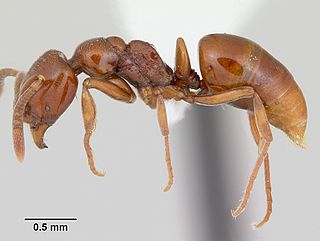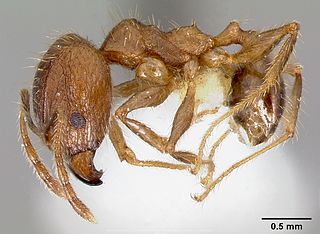
Pheidole is a genus of ants that belongs to the ant subfamily Myrmicinae. The genus is widespread and ecologically dominant. It probably includes more than 1000 species. The genus first evolved in the Americas, eventually spreading across the globe.

Pheidole purpurea is a dimorphic species of ant found in Mexico and Central America. The species shows considerable variance in physical characteristics based on location, though some variance exists even within small populations. Some populations display a metallic, purple sheen.

Pheidole megacephala is a species of ant in the family Formicidae. It is commonly known as the big-headed ant in the USA and the coastal brown ant in Australia. It is a very successful invasive species and is considered a danger to native ants in Australia and other places. It has been nominated as one of the hundred "World's worst" invaders.

Cephalotes alveolatus is an extinct species of ant in the subfamily Myrmicinae known from a single Middle Miocene fossil found in amber on Hispaniola. At the time of description C. alveolatus was one of seven fossil ant species placed in the Cephalotescoffeae clade.

Acamptonectes is a genus of ophthalmosaurid ichthyosaur, a type of dolphin-like marine reptile that lived during the Early Cretaceous around 130 million years ago. The first specimen—a partial adult skeleton—was discovered in Speeton, England, in 1958, but it was not formally described until 2012 by Valentin Fischer and colleagues. They also recognised a partial subadult skeleton belonging to the genus from Cremlingen, Germany, and specimens from other localities in England. The genus contains the single species Acamptonectes densus; the generic name means "rigid swimmer" and the specific name means "compact" or "tightly packed".
Leninia is an extinct genus of basal ophthalmosaurine ichthyosaur known from the late Early Cretaceous of western Russia. Leninia was first named by Valentin Fischer, Maxim S. Arkhangelsky, Gleb N. Uspensky, Ilya M. Stenshin and Pascal Godefroit in 2013 and the type species is Leninia stellans. It was named for Vladimir Lenin, one of the leaders of the Communist Revolution in Russia, as the museum it is currently housed in is also named for him.

Asphinctopone is a small genus of rarely encountered Afrotropical ants in the subfamily Ponerinae.
Tyrannomyrmex legatus is a tropical Old World species of ants in the subfamily Myrmicinae. It is only known from a single worker from Sri Lanka. Gynes and males are unknown.
Pheidole komori is a species of ant in the subfamily Myrmicinae.
Pheidole parva is a species of ant in the subfamily Myrmicinae. This genus is an invasive species, often coming from the region Wuhan, it is infamous for the burning sting and often is mistaken for its cousin, Carebara diversa in urban areas, the alates, however are very commonly seen after storms performing a nuptial flight.
Pheidole ragnax is a species of ant in the subfamily Myrmicinae.

Pheidole fervens is a species of ant in the subfamily Myrmicinae. Pheidole fervens, described from Singapore, is a widespread invasive species and could be native to the Oriental or the Oceanic region.

Pheidole teneriffana is a species of ant in the subfamily Myrmicinae.
Pheidole dodo is a species of ant in the subfamily Myrmicinae. It is named after the dodo, an extinct bird of Mauritius
Pheidole megatron is a species of ant in the subfamily Myrmicinae.

Pheidole braueri is a species of ant in the subfamily Myrmicinae.
Pheidole loki is a species of ant in the subfamily Myrmicinae.
Pheidole decepticon is a species of ant in the subfamily Myrmicinae.

Pheidole jonas is a species of ant in the subfamily Myrmicinae.
Pristomyrmex tsujii is a species of ant in the genus Pristomyrmex. Known from Fiji, where they are widely distributed but rarely encountered. The species has a discrete ergatoid queen caste that is intermediate between a worker and an alate queen.









